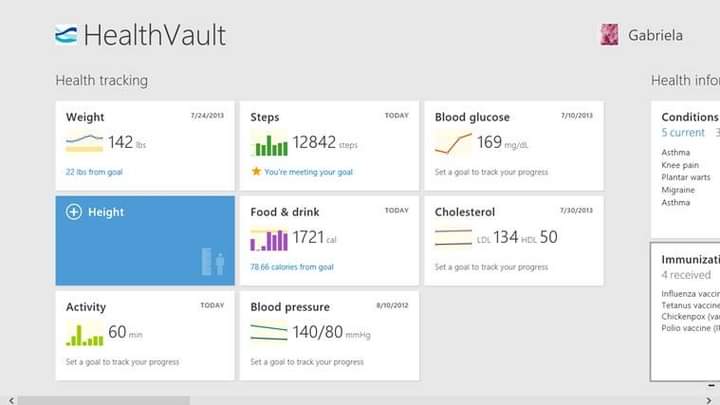Microsoft HealthVault was a web-based system for recording, storing, and maintaining digitised health information. Healthcare professionals and individuals could both use the service.
The health record system was launched in 2007; however, due to low user numbers, HealthVault was permanently shut down in 2019 — despite the popularity of health and wellness applications, and the fact that the system was created by one of the world’s biggest software companies.
So what was HealthVault? How was it used? And why was it closed?
Here’s a brief history of Microsoft’s healthcare record system and some of the lessons that the industry has taken from its failure.
What Was HealthVault?
HealthVault was set up to let users collect their own personal healthcare information. Microsoft launched the service with the support of Johnson & Johnson, the American Heart Association, and Allscripts.
Users could access information via the HealthVault website; however, its data could be shared with up to 120 different partner apps, including Microsoft Health, along with those of various hospitals and other providers.
Microsoft’s HealthVault was the first service of its kind to reach the market; however, the lack of actionable information and low user numbers meant that it also served as a lesson for competitors venturing into the field later.
When Was HealthVault In Operation?
Microsoft launched HealthVault in the United States in October 2007. The service was extended to the United Kingdom in June 2010.
Microsoft initially announced HealthVault’s closure on April 5th, 2019. The service was operational until November 20th, 2019.
Who Could Use HealthVault?
HealthVault was designed for individuals and healthcare professionals. As well as being able to access their own health records, parents could also manage their child’s records.
The system initially required users to have a HealthVault account which could be linked to a Windows Live ID, OpenID, or Facebook account; however, the ability to connect to Facebook and OpenID accounts was removed in May 2016.
Using HealthVault
Users could either use HealthVault records via the HealthVault website, or through a device or partner app that could connect to the platform.
When signing up to HealthVault for the first time, new users had to determine what data they would manage. Options included:
- Managing conditions
- Tracking prescriptions
- Managing lab test results
- Getting and staying fit
- Caring for family members
- Connecting with healthcare providers
Users could also create an emergency profile that included details about allergies, conditions, medications, and emergency contact information.
Using the HealthVault Connection Centre, it was possible to gather stats such as heart rate and blood pressure from connected medical devices. In 2014, Microsoft launched its own fitness tracker called Microsoft Band. Development and sales of this device were halted in 2016, and support for the companion app was discontinued in 2019.
HealthVault also allowed the storage of medical imaging records. Both consumers and providers could view, upload, and download DICOM-based images either through the website or by a licensed third-party imaging viewer connected to HealthVault.
What Went Wrong With HealthVault?
As with many tech projects, the failure of HealthVault wasn’t down to one specific issue. A catalogue of problems possibly contributed to the low user uptake.
Parallels could be drawn to Google Health which was launched in 2008 before being closed after just three years due to a lack of users. When Google wound down its health app, HealthVault was recommended as an alternative service.
As smartphones and wearable devices grew in popularity, HealthVault remained a largely browser-based experience without a mobile app. With no app, HealthVault missed the opportunity to gather telemetry data, information on health habits, and other user-generated input.
Over the years, the idea of integration with devices like FitBits was explored on several occasions, but these projects were always abandoned.
In an age when patient-acquired data from social sharing and smart wearable health technology was growing, HealthVault’s lack of attention to dynamic data was costly. The web-based app was predominantly focused on traditional health records. However, this type of data is only a fraction of the picture of an individual’s health.
Medical data in this format has limited use. These records were helpful for making insurance claims and for organisations processing healthcare billing but largely missed opportunities to add meaningful value in driving change in users’ health and wellbeing.
What Was HealthVault Insights?
Launched in 2017, HealthVault Insights was a seperate app that provided trend analysis to users and providers. This short-lived research project used machine learning to examine data gathered from Apple Health and Google Fit services.
Microsoft gave no formal explanation for the app’s closure in 2018; however, at the time, it was believed that the decision was based on a lukewarm reception, with the few reviews on Microsoft and Apple app stores achieving low average scores.
Microsoft’s Post HealthVault Focus
HealthVault’s demise coincided with a general shift at Microsoft from consumer-facing technology toward enterprise-level software. The company is now focused on developing services aimed at healthcare providers, allowing clinicians to share information securely and streamline interoperability and patient navigation.
At the helm of the changes is Gary Moore, Microsoft’s corporate vice president for health technologies and alliances. Using Microsoft Azure-based applications, Moore is charged with building healthcare partnerships.
What Next for Health Data?
Where the likes of HealthVault and Google Health have failed, Apple is looking for success. Launched in 2018, Apple Health Records connects with iPhones and Apple Watches for a connected user experience, allowing continuous monitoring and collection of health data.
But it doesn’t end there. Apple’s Health Records can also gather data from third-party devices like blood-sugar monitors.
What Happened to HealthVault Data?
After the closure of HealthVault, Microsoft deleted any data left in user accounts, and all apps reliant on any HealthVault data stopped working.
Before deletion, all HealthVault users could migrate their data to services such as Get Real Health and FollowMyHealth. Users were contacted before data deletion, giving them the opportunity to migrate.

